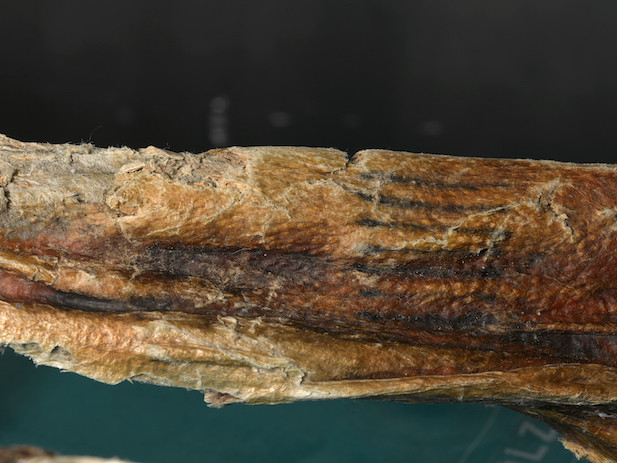The quest to identify the world’s oldest tattoos has been a captivating debate within archaeology and tattoo history. For a long time, the spotlight shone on a mummy from the Chinchorro culture in South America, believed to sport a delicate mustache tattoo. However, recent scientific findings have shifted the paradigm, definitively crowning Ötzi, the European Tyrolean Iceman, as the bearer of the most Ancient Tattoos known to humankind. Frozen in time beneath an Alpine glacier along the Austrian–Italian border around 3250 B.C., Ötzi’s remarkably preserved body reveals an astonishing 61 tattoos etched across his skin, marking a pivotal point in our understanding of ancient body art. These markings, located on areas including his left wrist, lower legs, lower back, and torso, offer an unprecedented glimpse into the tattoo practices of our distant ancestors.
The Ötzi Iceman: A Window into Ancient Tattooing
Previously, the title of “oldest tattoos” was hotly contested. Many scholars leaned towards the Chinchorro mummy, unearthed in El Morro, Chile. This mummy’s age, estimated to be around 4000 B.C., coupled with its faint mustache tattoo, positioned it as a leading contender for the earliest known evidence of tattooing.
However, a groundbreaking study published in the Journal of Archaeological Science: Reports, spearheaded by researchers including Lars Krutak from the Smithsonian’s National Museum of Natural History, re-evaluated the age of the Chinchorro mummy. Their meticulous analysis concluded that the Chinchorro mummy is not as ancient as initially proposed, thereby solidifying Ötzi’s status as the owner of the oldest confirmed tattoos.
Krutak, reflecting on the findings, admitted his initial surprise, stating, “I was surprised by the findings because in previous publications I brought attention to the tattooed Chinchorro mummy and its early date. To me this mummy was like an underdog versus the all-too-popular Iceman that everyone was writing and talking about. But after reviewing the facts, we were compelled to publish the article as soon as possible to set the record straight and stem the tide of future work compounding the error.” This revelation underscores the dynamic nature of archaeological research and the importance of continuous re-evaluation in light of new evidence.
Challenging the Chinchorro Mummy: A Shift in Tattoo History
The art of tattooing boasts a rich and extensive history, with written records tracing it back to fifth-century B.C. Greece and potentially even earlier in China. Beyond written accounts, tangible evidence of tattooing emerges from various sources, including ancient artwork, preserved tattoo tools, and most significantly, tattooed human skin. The latter provides the most compelling and direct archaeological proof of this ancient practice.
 Illustration showing facial tattoos of the Chinchorro mummy, highlighting cosmetic ancient tattoos.
Illustration showing facial tattoos of the Chinchorro mummy, highlighting cosmetic ancient tattoos.
Radiocarbon dating, a crucial technique in archaeology, played a pivotal role in resolving the debate between Ötzi and the Chinchorro mummy. This method measures the decay of carbon-14 in organic materials to estimate their age, allowing researchers to accurately determine the antiquity of both the Iceman and the South American mummy.
Ötzi, having been the subject of intense scientific scrutiny for over two decades, has yielded a wealth of information about his life, health, and environment. Extensive radiocarbon dating of his clothing and tools has been conducted, and his tattoos, notably clustered around areas of joint and spinal degeneration, are hypothesized to be therapeutic in nature.
In contrast, the Chinchorro mummy remained relatively unstudied until recently. Researchers embarked on a mission to ascertain his identity, age, and the characteristics of his tattoo, leading to a significant discovery regarding the accuracy of previous dating.
Lost in Transcription: Unraveling the Dating Discrepancy
During their investigation, the research team unearthed a critical error in the interpretation of the Chinchorro mummy’s radiocarbon dating. A sample of lung tissue, radiocarbon dated in the 1980s, initially yielded a date of 3830 ± 100 B.P. (Before Present). However, the researchers propose that a transcription error occurred, misinterpreting B.P. as B.C., which was subsequently repeated in later studies. This seemingly small error inflated the mummy’s age by approximately 4,000 years, incorrectly positioning it as older than Ötzi.
 Body tattoos of Ötzi the Iceman, revealing patterns of ancient therapeutic tattoos.
Body tattoos of Ötzi the Iceman, revealing patterns of ancient therapeutic tattoos.
This corrected dating firmly establishes Ötzi as older than the Chinchorro mummy by at least five centuries, resolving the long-standing debate about the oldest tattoos. While Ötzi currently holds the title, the researchers emphasize that this is likely a temporary designation. Ötzi’s tattoos hint at established social and therapeutic tattooing practices that predate him, suggesting that future archaeological discoveries and advancements in dating techniques may unearth even older examples of tattooed mummies.
The Enduring Legacy of Ancient Tattoos
Krutak aptly summarizes the broader significance of these findings, stating, “Apart from the historical implications of our paper, we shouldn’t forget the cultural roles tattoos have played over millennia. Cosmetic tattoos—like those of the Chinchorro mummy—and therapeutic tattoos—like those of the Iceman—have been around for a very long time. This demonstrates to me that the desire to adorn and heal the body with tattoo is a very ancient part of our human past and culture.”
The world’s museums and collections house countless ancient mummies, many of which remain unexplored for tattoo evidence. Krutak expresses hope that this research will stimulate renewed investigation, potentially pushing back the known timeline of tattooing even further. The prospect of uncovering even more ancient tattoos is an exciting one, promising to deepen our understanding of this enduring and globally prevalent art form and its profound connection to human history and culture.
